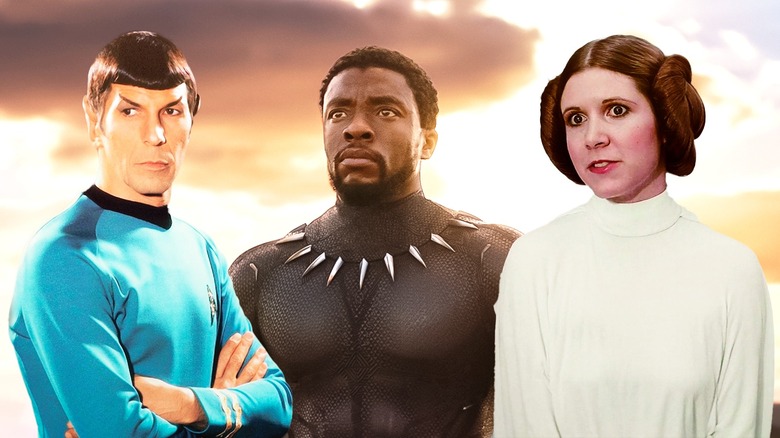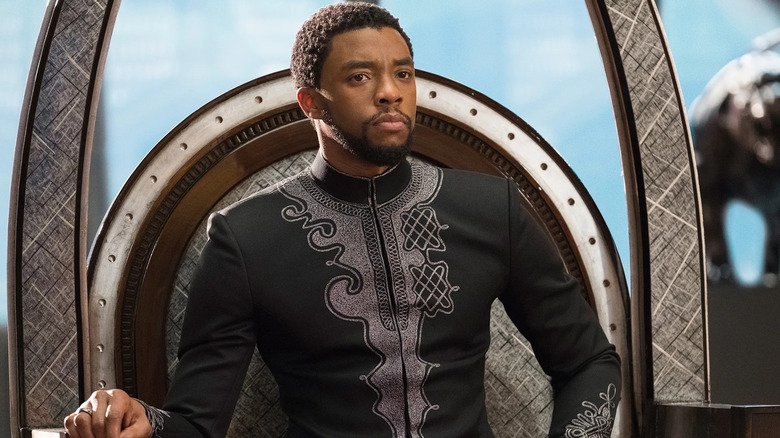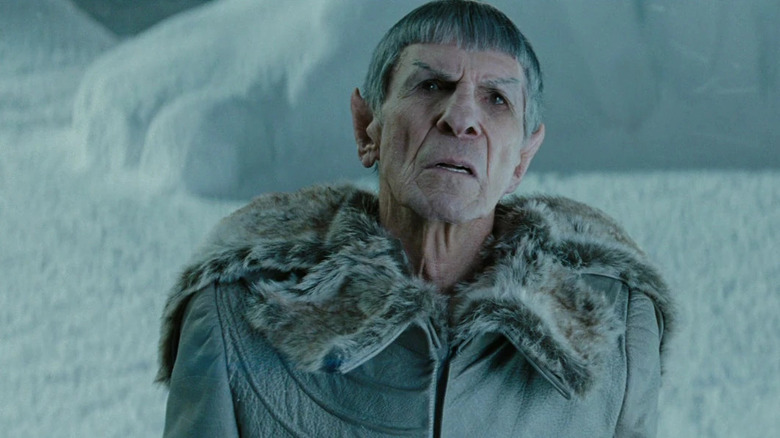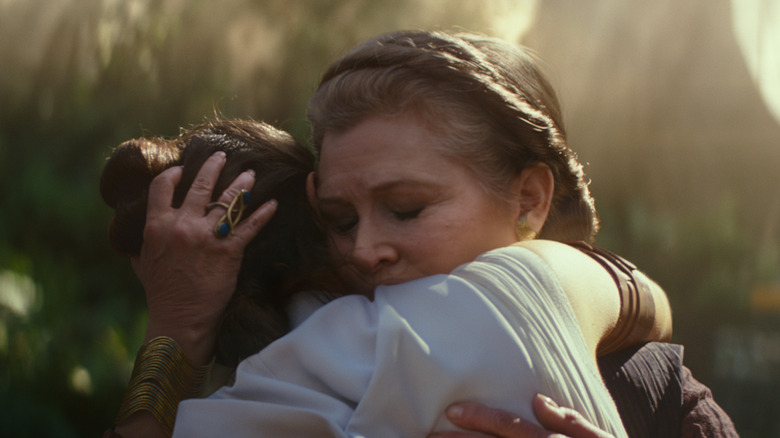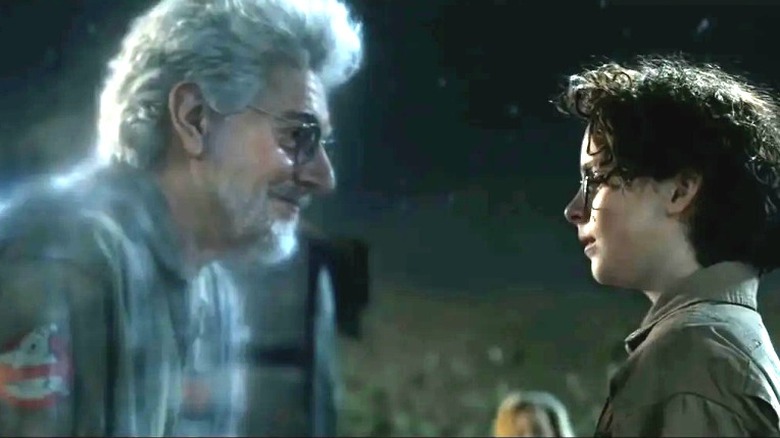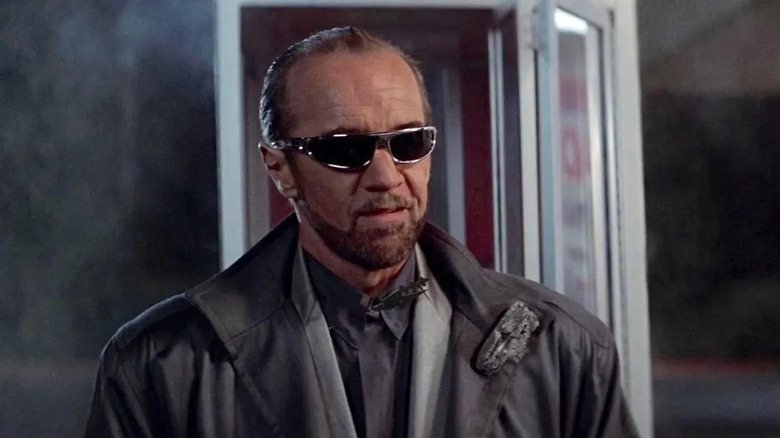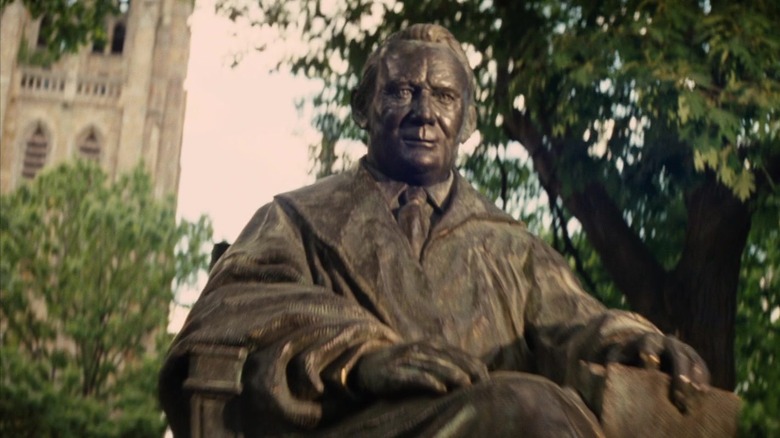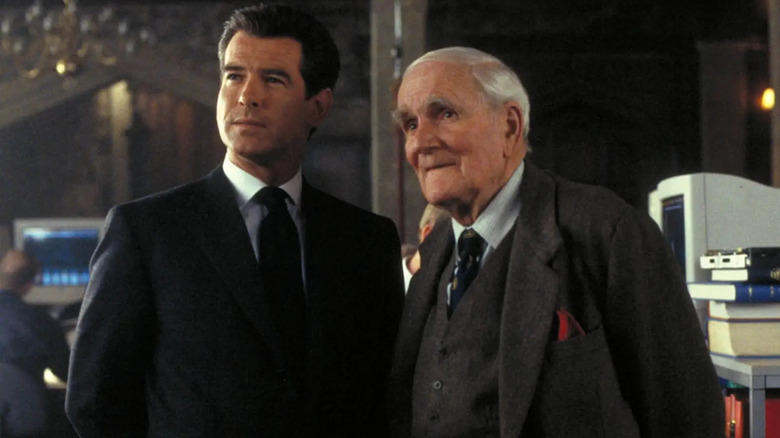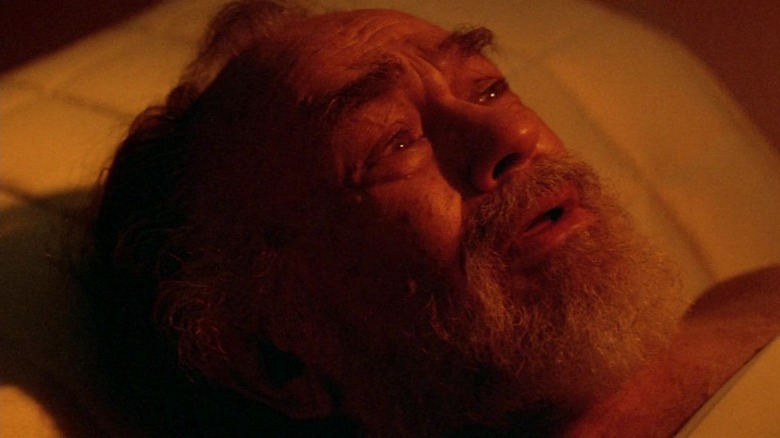Sci-Fi Movie Characters That Died Because The Actor Passed Away
In many notable film franchises, the property is bigger than the individual performers. So when an actor associated with a particular role dies, it's not the end of the character. In some cases, as with Michael Gambon replacing the deceased Richard Harris as Harry Potter's mentor Albus Dumbledore, it can arguably even be an improvement. In others, like the creepy Peter Cushing digital mask used in "Rogue One," the viewer may wish the writer had cleverly written around the loss.
However, some people just become so iconic in the roles they play that recasting them just seems like a terrible idea all around. Not only that, but it can help their longtime costars to mourn the character, as well as the actor, rather than simply pretending they're still alive in that universe (cough — Paul Walker — cough). In the case of several high-profile science fiction movies, acknowledging the death in canon was the decision made, and for the most part, a tasteful and popular one. Here are seven examples, plus one semi-honorable kinda-mention that almost counts, of occasions where a character in a science fiction movie died because the actor already had.
Chadwick Boseman as T'Challa
When Chadwick Boseman was originally cast as Black Panther aka King T'Challa for the Marvel Cinematic Universe, with the character's debut set for "Captain America: Civil War," he didn't have cancer. He was diagnosed in 2016 but kept his condition private until his death in 2020. During that time, he headlined the first "Black Panther" movie, which was a massive box office hit and earned widespread critical acclaim. Its success established Boseman's T'Challa as a generational superhero for kids who'd never seen themselves in one before. He became synonymous with the role and was as irreplaceable as Christopher Reeve once was for Superman.
When Boseman died early in the development of the sequel, "Black Panther: Wakanda Forever," Marvel had some hard choices to make. Yet, they promised pretty early on neither to recast nor use a CG double. This left only the choice to acknowledge the death upfront, as T'Challa dies offscreen of a mysterious disease during the opening scene. The fans who wanted to recast T'Challa got thrown a bone, however — at the end of the film we meet his young son, who's also named T'Challa.
Leonard Nimoy as Spock Prime
Rebooting "Star Trek" onscreen with new actors seemed like a fool's errand that hardcore fans would rebel against ... until Leonard Nimoy came aboard. By including the original Spock, now dubbed Spock Prime, as a bridge between alternate realities, "Star Trek" (2009) made itself both a sequel and a reboot. Paradoxically, it remained in canon even while establishing a new one. Thank Nimoy for that — it's hard to imagine now that the beloved sci-fi icon once wanted to distance himself from the role, and even had himself killed off in the second-ever "Star Trek" movie way back in 1982 so he wouldn't have to do more if he didn't want to.
Clearly, director J.J. Abrams agreed, and more awkwardly shoehorned the actor into "Star Trek Into Darkness" as a deus ex machina. Having the younger Spock (Zachary Quinto) ask Spock Prime how he dealt with Khan felt like lazy scripting, though it was still good to see him again. By the third Kelvin Timeline movie, "Star Trek Beyond," Nimoy had passed away. To keep his streak of appearances unbroken, the narrative simply acknowledged that Spock Prime had died too, and showed him in an old crew photo from the original films. Once again, it tied the Kelvin universe to official canon and allowed cast members to pay tribute in character.
Carrie Fisher as General Leia Organa
Carrie Fisher died in 2016, before "Star Wars: The Last Jedi" was released, which added some tension to that movie's story. During a scene in which General Leia gets sucked into the vacuum of space, it seemed the filmmakers would kill off the character then and there. However, Leia survived the film's events, putting Lucasfilm in a difficult spot when developing the sequel trilogy finale, "Star Wars: The Rise of Skywalker." In contrast to what Marvel would later do with Chadwick Boseman's T'Challa, it was decided Fisher's Leia would be in the film, through a clever combination of CGI, recycled outtakes, and a script carefully written around existing Fisher lines.
While "The Rise of Skywalker" could have begun with Leia's funeral, she was deemed too essential to the plot, filling in crucial between-the-trilogies backstory and maintaining a pattern of having each of the final three installments be one of the core three legacy heroes' last bow. In the end, however, the story does allow the character to become one with the Force, sacrificing her last life energy to save Rey (Daisy Ridley) and redeem prodigal son Ben (Adam Driver).
Harold Ramis as Egon Spengler
For years, fans and Dan Aykroyd clamored for another "Ghostbusters" sequel. When the 2016 reboot failed, talks finally began in earnest, though it probably helped that Sony actually did manage to wrangle every major surviving cast member together to do cameos for another installment. Even with Bill Murray and Aykroyd finally on the same page, though, there was a big story problem. Harold Ramis, who played the team's main brain Egon Spengler, was dead.
Not everyone came out of "Ghostbusters: Afterlife" satisfied with the way the movie killed off Egon (initially played in darkness by a double), then resurrected him as a ghost. Even in a franchise routinely considered libertarian nowadays, the notion of Egon falling out with the team and moving to the country as an off-the-grid crank felt a bit out-of-character, and maybe a bit too libertarian. Despite that, and the ludicrous sudden appearance of the old team in full costume at the end, the digitally created Egon ghost looked convincing enough to bring a tear to the eye. The threequel may have excessively recycled plot elements, but it allowed fans and costars to truly feel a warm goodbye to the popular character and actor.
George Carlin as Rufus
"Bill and Ted Face the Music" had to also face the fact that the air-guitar-loving duo no longer had George Carlin around to play time-traveling mentor Rufus. Originally, director Dean Parisot did intend to use CG for Rufus to interact with Bill (Alex Winter) and Ted (Keanu Reeves), but perhaps mercifully, the movie didn't have the budget to do it. Instead, Rufus' death was acknowledged via hologram, with the character's daughter Kelly (Kristen Schaal) and widow The Great Leader (Holland Taylor) playing prominent roles to complete the promise he made that Bill and Ted's music would save the world. Archival footage of Carlin was combined with dialogue by an impersonator.
Storywise, Rufus might have been the one character on this list who'd have died anyway. Mentor figures in sci-fi, like Obi-Wan Kenobi or Yoda, inevitably have to be taken out of the narrative so the heroes can rise or fall on their own merits. And while Rufus did a pretty good job of standing back, Bill and Ted themselves must become the elder teachers by the end of "Face the Music." It's fitting because Keanu Reeves is now at least as beloved a pop culture icon as George Carlin was in the '80s.
Denhom Elliott as Marcus Brody
Wait a moment. What's the "Indiana Jones" franchise doing on a list of sci-fi characters? On the whole, the Steven Spielberg-directed films are action-adventure, with small fantasy elements. We're not talking about the whole franchise here, though. Just "Kingdom of the Crystal Skull," which has aliens, or extra-dimensional beings, if we're talking semantics. That alone makes it sci-fi, but the fact that it's also rooted heavily in atomic-era sci-fi tropes of the '50s helps a lot.
And it's in this one that Indy mourns dead friends and family. We see a photo of the late Henry Jones Sr. (played by Sean Connery, who wasn't yet dead) and a statue in honor of Marcus Brody, played by Denholm Elliott (who passed in 1992). Brody had appeared in two of the prior three Indy adventures, first as a more serious colleague in "Raiders of the Lost Ark," then as comedic relief who's helpful, but bumbling, in "The Last Crusade."
There was no compelling need for Brody to appear or even be mentioned in the fourth film. More prominent characters like Willie Scott and Short Round have never been heard from again, and Indiana's complete lack of acknowledgment of them would be shocking in a real human being. Still, it was nice to see the franchise acknowledge its deceased alumnus.
Desomnd Llewelyn as Q
James Bond is probably the franchise best known for recasting. Unlike Batman and Spider-Man, which tend to reboot their movies when new stars come aboard, Bond even tried to loosely maintain series continuity across the tenures of Sean Connery, George Lazenby, Sean Connery again, Roger Moore, Timothy Dalton, and Pierce Brosnan. Bond himself isn't even the only one to be recast as if nothing's happened: M, Moneypenny, Felix Leiter, and Blofeld also routinely changed actors without acknowledging it.
Q was different. At 85 years old, Desmond Llewelyn had been a series constant, though perhaps sensing an imminent aging out, producers gave him a protegee named R (John Cleese) in "The World Is Not Enough," which turned out to be his final film. Ironically, it wasn't old age that took him in the end, but a fatal car crash. By the next film, R had been promoted to Q, in a rare acknowledgment that the role hadn't just been recast, but the character succeeded. They don't flat-out say the previous Q died, but it's implied. After playing the character 17 times, he couldn't just be swapped out.
Honorable Semi-Mention: Edward G. Robinson as Sol Roth
"Soylent Green" imagines a terrifying future world of 2022, where the planet is hotter, overpopulation abounds, oceans have been overfished, unmodified real food is hard to come by, the government is cool with the old and vulnerable dying just to keep business going, and rich and poor have been drastically stratified in different living conditions. Whew ... good thing that was fiction, right?
The movie is best known for its big, cannibalistic twist, though it's so much more than just a mystery about ingredients. It's second-best known for being the 101st and final film of acclaimed actor Edward G. Robinson, who even now is so often the template for impersonations of movie gangsters. It's a stretch to say that the character of Sol Roth died because Robinson did ... but he played his big death scene knowing he was dying of cancer, even though nobody else on set did. Roth, an old man who remembers a better world less ravaged, ultimately opts for assisted suicide rather than continue living in a world where human flesh gets reprocessed as fake plankton. The process involves him lying down to die as images of the old world project on large movie screens around him to put him at peace.
"How could I know? How could I ever imagine?" asks Charlton Heston as Thorn, upon seeing such footage for the first time. As Robinson died two months after the movie was finished, virtually everyone knew when they watched it.
